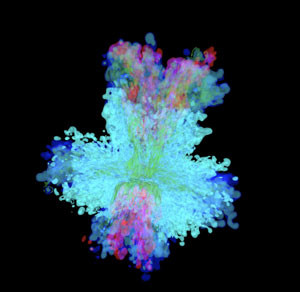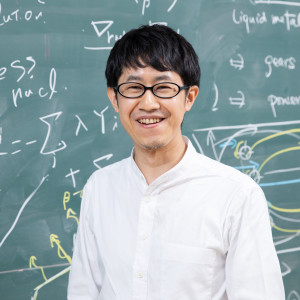Volume 95
Back to Newsletter List
Award
Dr. Ryosuke Iritani received Suzuki Prize of The Ecological Society of Japan
2020-03-24
Ryosuke Iritani received "Suzuki Prize of The Ecological Society of Japan" on March 7, 2020, for his contribution to a wide range of evolutionary ecology as an early career theoretical researcher. Congratulations, Ryosuke!
Research News
RIKEN Research: Merger between two stars led to iconic supernova -- Simulations suggest that two stars came together to form a blue supergiant, which subsequently exploded
2020-03-19
A supernova in a nearby galaxy may have originated from an explosion of a blue supergiant formed by the merger of two stars, simulations by RIKEN astrophysicists suggest1. The asymmetric nature of this explosion may provide hints for where to look for the elusive neutron star birthed in this stellar cataclysm.
A core-collapse supernova occurs when the core of a massive star can no longer withstand its own gravity. The core collapses in on itself, triggering a violent explosion that blasts away the star’s outer layers, leaving behind a neutron star or black hole.
In 1987, astronomers saw a star explode in the Large Magellanic Cloud, one of our galaxy’s closest neighbors. Since then, scientists have intensively studied the aftermath of this supernova, known as SN 1987A, to understand the nature of the progenitor star and its fate.
The progenitor of this type of supernova is usually a red supergiant, but observations have shown that SN 1987A was caused by a compact blue supergiant. “It has been a mystery why the progenitor star was a blue supergiant,” says Masaomi Ono at the RIKEN Astrophysical Big Bang Laboratory.
Upcoming Event
Colloquium
iTHEMS Colloquium
Interaction Models in Quantum Optics, Representation Theory and Number Theory
April 10 (Fri) 15:30 - 17:00, 2020
Masato Wakayama (Senior Advisor, RIKEN Interdisciplinary Theoretical and Mathematical Sciences Program (iTHEMS) / Vice President, Tokyo University of Science)
Recently, interaction models originated in quantum optics, with the quantum Rabi model (QRM) as a distinguished representative, are appearing ubiquitously in various quantum systems including cavity and circuit quantum electrodynamics, quantum dots and artificial atoms, with potential applications to quantum information technologies such as quantum computing. Together with the integrability of QRM, demonstrated by Daniel Braak in 2011, this has led to wide discussion and development of various aspect of the QRM and its generalizations from the point of view of theoretical physics and mathematics.
In this talk, firstly, we characterize the structure of the spectra of QRM and its asymmetric version via sℓ2-representations. Secondly, we introduce the non-commutative harmonic oscillator, which may be considered to be a “cover” of the QRM in the Heun ODE picture, and describe certain number theoretical aspects arising from its spectral zeta function. Further, we discuss the heat kernel and partition function of the QRM toward the number theoretical investigation of the model. In addition, a number of related open problems will be presented.
Venue: via Zoom
Event Official Language: English
If you would like to cancel your subscription or change your email address,
please let us know via our contact form.
Copyright © iTHEMS, RIKEN. All rights reserved.






